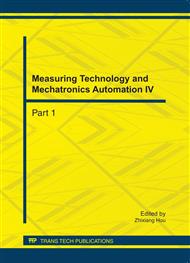p.975
p.979
p.985
p.990
p.994
p.998
p.1006
p.1010
p.1015
Selection of Optimal Measure Project for Automatic Test System
Abstract:
An optimal solution of multi-objective optimization has been proposed for the measure project of automatic test system (ATS) because of the formation complexity and the factors diversity. The method is used to select the optimal measure project for ATS. First a quasi-ideal solution is defined using maximum subjection principle from fuzzy theory. Then calculate the subjection of the existing projects and get their maximum subjection under specific weight set. Finally the optimal measure project has been obtained. The signal integrity, data throughput, cost, degree of automation, volume scale and expansion capabilities are regarded as integrated key factors according to bus forms and system architecture. The optimal measure project of ATS is determined by finding maximum subjection. Therefore the selection method enhances the cost-effectiveness of ATS formation.
Info:
Periodical:
Pages:
994-997
Citation:
Online since:
October 2011
Authors:
Price:
Сopyright:
© 2012 Trans Tech Publications Ltd. All Rights Reserved
Share:
Citation:


